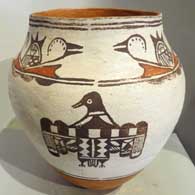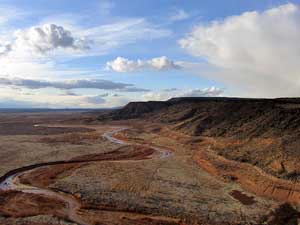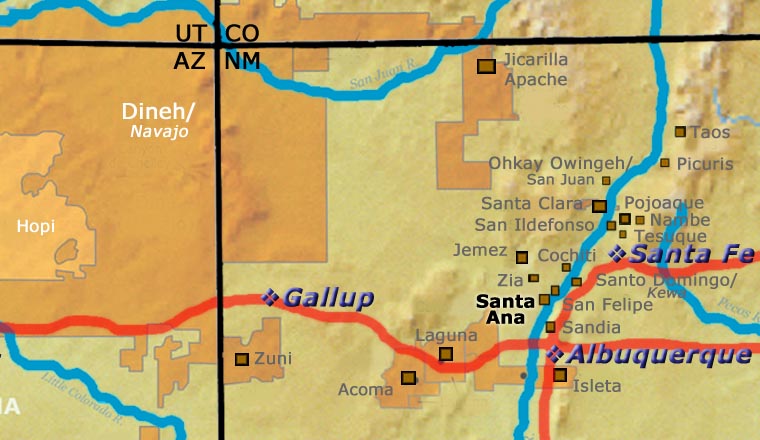
Eudora Montoya
1905-1995
Santa Ana
Eudora Montoya was born into Santa Ana Pueblo in 1905. At the time there were only about 225 residents of the pueblo. She recalled learning to make pottery from her mother in the 1920s. She also remembered her mother saying she had learned from her mother.
In those days, like so many other Pueblo children, she was sent away to an Indian boarding school, returning home only in the summers. Every summer she'd work with her mother making bean pots (mostly) and watching as her mother would stir the paint in her black pot and paint traditional Santa Ana designs on those bean pots.
In 1946 Eudora turned to making pottery full time and recalled there were still a few ladies making old-style pots. She explained "I like the mud, to work it, and I missed doing it." As time went on, though, the other women got older and finally, Eudora was the only active potter in Santa Ana.
In 1972, at the urging of Nancy Winslow (a non-Indian woman from Albuquerque), she started teaching a pottery class on the pueblo. In her first year she had 17 students working with her in a revival project to preserve Santa Ana-style pottery.
She kept making pottery and kept teaching others until in 1988, Indian Market Magazine honored her in a featured artist's profile saying "Eudora Montoya is a small, self-effacing woman, but as a bearer of Pueblo Indian culture her contribution has been larger than life. Through her efforts and the knowledge she safeguarded, the centuries-old tradition of Santa Ana-style pottery, once in danger of extinction, remains vitally alive."
Eudora earned several awards for her pottery at the Santa Fe Indian Market. She passed on in 1995.
100 West San Francisco Street, Santa Fe, New Mexico 87501
(505) 986-1234 - www.andreafisherpottery.com - All Rights Reserved

Santa Ana Pueblo

The Jemez River on Santa Ana Pueblo
The Santa Ana people have occupied the area around today's pueblo since the 1500s. As Eastern Keres speakers they most likely arrived from the area of Frijoles Canyon in what is now Bandelier National Monument. Tamaya, their first pueblo in the new location, was located against a south-facing rocky mesa wall on the north side of the Jemez River. That location was well off the usual trade and travel routes in the area, making Tamaya one of the most secluded of all New Mexico pueblos.
The first Spanish arrived in the region in 1540 and while they attacked most of the Tiwa villages in the area before moving on, Tamaya was never found until 1598. Doesn't matter, after being found, the Spanish treated them just as badly as they treated everyone else in the valley. Abuses from the Spanish authorities and the hated priests led to the Pueblo Revolt of 1680 when the Pueblo peoples rose up together and forced the Spanish from Nuevo Mexico. Their freedom lasted for 12 years. The Spanish invaded several times in those years, until 1692 when they returned in force, intent on staying. In the fighting after the Spanish return, the Santa Anans were forced to flee from their villages and hide in the mountains and valleys to the north and northwest. The Spanish looted and burned everything they left behind. Some of the Santa Anas gathered on Black Mesa before descending into the valley and surrendering to Spanish rule again in 1693. Others who had fled further took longer to come back. Some of them had fled to sites in Gobernador Canyon to the north while others fled into the upper reaches of the Jemez Mountains or to Hopi country. Eventually they virtually all returned and surrendered to the Spanish.
The tribe began rebuilding their pueblo, then they moved to acquire more agricultural land along the Rio Grande. They supplemented their diet by hunting and gathering but slowly their tribal village industry economy shifted as more people became involved in the village agricultural economy and their trade changed until they were offering food in return for pottery from their Zia and Jemez neighbors. Those tribal members who still produced pottery in those days mostly emulated the creations of the Zias. Then the tribe moved downstream closer to the Rio Grande and new sources of clay and temper were found. Still, by the 1920s the Santa Ana pottery tradition was nearly extinct. Then Eudora Montoya (the last traditional Santa Ana potter) began holding classes to teach what she knew to other women in the tribe in the 1970s. Little pottery production, however, exists today at Santa Ana.
100 West San Francisco Street, Santa Fe, New Mexico 87501
(505) 986-1234 - www.andreafisherpottery.com - All Rights Reserved
